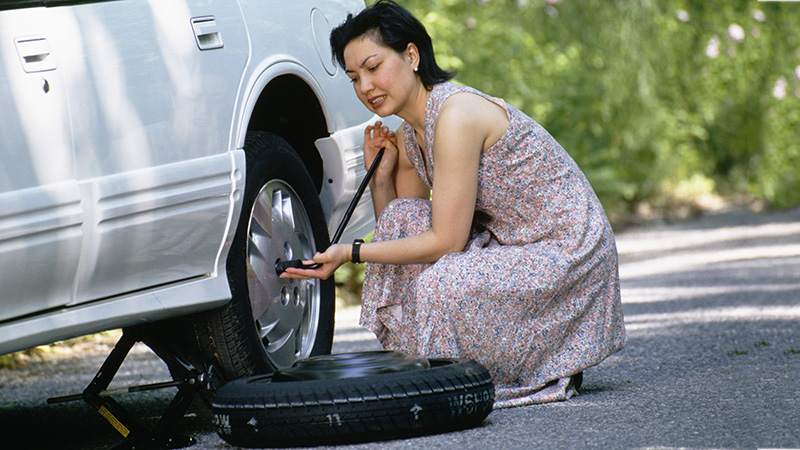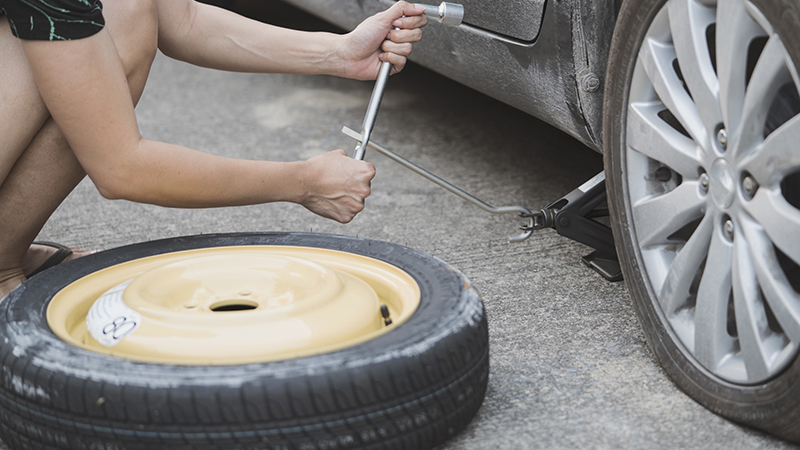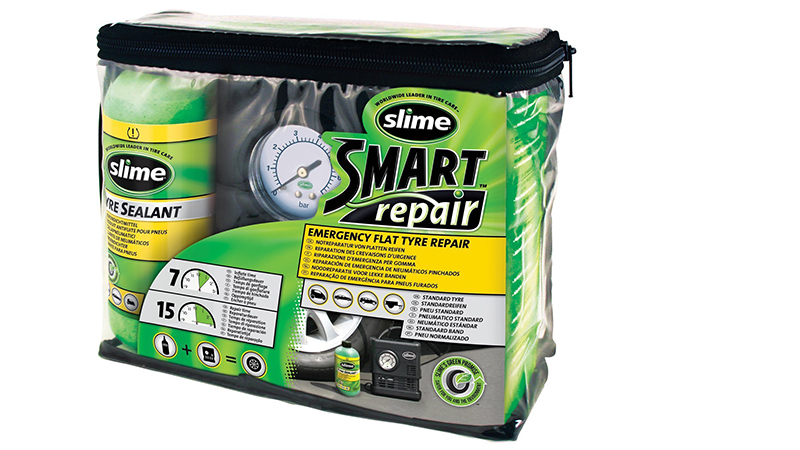Suffered a puncture recently? It’s likely the spare wheel you found wasn’t what you were expecting… perhaps it wasn’t a wheel at all?
We look at the increasing number of so-called ‘non-standard’ solutions provided for drivers after they suffer a blowout.
Find out everything from what type of ‘spare’ you might have to how long you can use it for and what driving restrictions apply.

The moment we all dread.. having to change a wheel: Credit Thinkstock/Jupiterimages
What’s the problem? I just fit my spare wheel right?
There was a time when cars came with five identical wheels, with the spare ready to slot into action at the twist of a jack!
However, the proliferation of expensive alloy wheels coupled with an ever-increasing need to save space and weight, the ‘spare’ has shrunk or even disappeared altogether.
What are the new ‘spare wheels’ then?
Most car makers deliver vehicles with either a non-standard spare – aka ‘space saver’ wheel – or a tyre sealant and inflation kit. Some might also fit ‘Run Flat’ tyres.
Here’s all you need to know about how each solution works.
Space saver wheels

The space saver will get you to safety but it’s not a long-term solution: Credit Thinkstock/Tatomm
What are they: These are much thinner than standard car tyres and can be fitted to a vehicle in the event of a puncture.
Are they safe to use: Yes. Provided drivers are aware of the restrictions that apply to their use. Users must remember space saver wheels are intended to get the vehicle to a place of safety and not day-to-day motoring.
Is there a maximum speed for space saver wheels: The maximum speed restriction for a space saver wheel is likely to be 50mph.
Exceeding this is dangerous and could result in prosecution. The wheel itself should have a label or moulding that carries its speed restriction.
Is there a maximum distance for space saver wheels: There is no official restriction on how far a driver can travel on a space saver wheel, but around 50 miles is considered to be the maximum safe distance.
The tyre will have a shallow tread depth, compared with standard tyres, and this will degrade at a faster rate due to the narrow gauge of the wheel. Using a space saver wheel will reduce the car’s cornering grip by 10-15 per cent.
Tread depth rules apply to space saver wheels in the same way as they do to standard tyres.
Can space saver wheels be used front and back: Check your handbook, because some vehicles have restrictions on where they can be used for safety reasons. Never use more than one space saver wheel on a vehicle at any one time.
Will there be any difference in how the car drives: Yes. It’s likely the car’s handling will be changed by the non-standard wheel. This will reduce the vehicle’s cornering and braking abilities.
Can space saver wheels be used on motorways: It’s not illegal, but driving at 50mph is dangerous on motorways. HGVs will be travelling at 56mph, so a car moving at just 50mph in the left-hand lane is likely to cause a dangerous obstruction. Avoid motorways if at all possible.
Remember to check the space saver’s air pressure: The majority of space saver wheels have pneumatic tyres, so you’ll need to periodically check your ‘spare’ is at the correct pressure. Driving on an under-inflated space saver would be extremely dangerous.
Can I use a space saver wheel for my MOT: Not unless you want to fail. Wheels of the same ratio must be fitted to each axle.
VERDICT: Changing a wheel has become a bit of a dying art, but for those who are confident with a jack and brace, the space saver offers a virtually guaranteed roadside get out of jail card for anyone who’s suffered a puncture or blowout.
Tyre sealant and inflator kits

Have you got a tyre sealant kit in your car? Credit Slime
What are they: When car makers want to save space and weight, they often swap the bulky spare for a tyre sealant and inflator kit – or a pre-fit a ‘pre-puncture’ sealant. Here’s what you need to know about both.
‘Pre-puncture’ sealant kit: Making it even more complicated, your car might be fitted with ‘pre-puncture’ sealant, which is already injected in the tyre and will instantly seal a puncture as it happens. The danger with this method is that motorists may be left unaware that they’ve even suffered a problem.
Make sure you check your handbook to see if you have ‘pre-puncture’ sealant and follow instructions on how to monitor if it has been deployed’
Sealant kit and inflator: Look out for an aerosol can and electric tyre inflator. Some kits simply consist of a single ‘can’ that will both seal and inflate the tyre.
How do the tyre sealant kits work: The sealant and compressed air are delivered through the tyre’s valve. The sealant plugs the damage and the air inflates the tyre – leaving the driver to make for safety…
Sounds amazing: It does seem to be a simple, no-hassle solution that will avoid getting your hands dirty – but the sealant kits won’t work in the event of a ripped tyre or larger blowout. This could leave the motorist stranded at the roadside without any self-contained options.
Are these sealant repairs permanent: No. Like space saver wheels they should be treated as a temporary repair to get the vehicle to a place of safety and a full repair should take place as soon as possible.
Are there speed restriction on tyres that have had punctures fixed in this way: There are no official speed restrictions, but check the instructions on the sealant product used. Professionals advise moderating speed, because there may be serious damage to the tyre that could cause it to suddenly degrade.
VERDICT: A handy solution for those without a mechanical inclination, but serious rips, tears or blowouts will leave them stranded with this puncture repair option.
Run Flat tyres
What are they: Run Flat tyres are designed to allow a car to keep moving after suffering a puncture. This means there’s no need to stop and change a wheel, or seal a tyre at the side of the road. An attractive solution for dark, cold winter nights.
How do they work: These tyres are constructed with reinforced sidewalls that won’t collapse in the event of a puncture or blowout. The tough rubber inserts take the place of compressed air – making it possible to continue driving.
How long can they driven on after a puncture: After a puncture, it should be possible to drive at around 30mph for up to 50 miles.
Is there a speed limit for deployed Run Flat tyres: Follow guidelines for each individual tyre.
Is this the perfect solution: It might seem like it, but there are plenty of cons to counter the pros. Cost and an uncomfortable ride are bug-bears for many users. Additionally, Run Flat tyres can’t be repaired so will need replacing after any minor damage.
VERDICT: If money isn’t a concern then these tyres are likely to make sense. However, there is the side-effect of a ride that isn’t as smooth as on conventional rubber.
